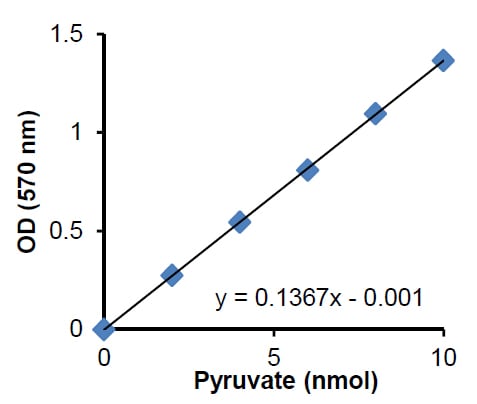Pyruvate Assay Kit (ab65342)
Key features and details
- Assay type: Quantitative
- Detection method: Colorimetric/Fluorometric
- Platform: Microplate reader
- Assay time: 40 min
- Sample type: Cell culture extracts, Other biological fluids, Plasma, Serum, Tissue Extracts, Urine
- Sensitivity: 1 µM
Overview
-
Product name
Pyruvate Assay Kit -
Detection method
Colorimetric/Fluorometric -
Sample type
Urine, Serum, Plasma, Cell culture extracts, Other biological fluids, Tissue Extracts -
Assay type
Quantitative -
Sensitivity
> 1 µM -
Range
1 µM - 200 µM -
Assay time
0h 40m -
Product overview
Pyruvate Assay Kit (Colorimetric/Fluorometric) ab65342 provides a simple, direct and automation-ready procedure for measuring pyruvate concentration in various biological samples such as blood, cells, culture and fermentation media, etc.
In the pyruvate assay protocol, pyruvate is oxidized by pyruvate oxidase via enzyme reactions to generate color (λ= 570 nm) and fluorescence (at Ex/Em = 535/587 nm). Since the color or fluorescence intensity is proportional to pyruvate content, the pyruvate concentration can be accurately measured.
The kit detects 1-200 µM pyruvate.
Pyruvate assay protocol summary:
- add samples and standards to wells
- add reaction mix and incubate for 30 min at room temp
- analyze with microplate reader -
Notes
This product is manufactured by BioVision, an Abcam company and was previously called K609 Pyruvate Colorimetric/Fluorometric Assay Kit. K609-100 is the same size as the 100 test size of ab65342.
-
Platform
Microplate reader
Properties
-
Storage instructions
Store at -20°C. Please refer to protocols. -
Components 100 tests 2000 tests Assay Buffer IV 1 x 25ml 20 x 25ml Development Enzyme Mix I 1 vial 20 vials OxiRed Probe 1 x 200µl 20 x 200µl Pyruvate Standard 1 x 100µl 20 x 100µl -
Research areas
-
Relevance
Pyruvate is a key intersection molecule in the netwrok of metabolic pathways. Pyruvate can be made from glucose through glycolysism converted back to carbohydrates via gluconeogenesis, or to fatty acids or energy via acetyl CoA. It can also be used to construct the amino acid alanine and be converted to ethanol. Glucose is converted to pyruvate which is then converted into acetyl CoA, the main input for the citric acid cycle (TCA). If insufficent oxygen is available, pyruvate breaks down anaerobically, creating lactate in animals and ethanol in plants and microorganisms.
Images
-
 Functional Studies - Pyruvate Assay Kit (ab65342)Kaur, Gursharan et al., Scientific reports vol. 7,1 11645., Fig 2, doi:10.1038/s41598-017-12004-3Pyruvate levels under manganese stress and iron supplementation were measured with ab65342 and the results were plotted as a function of normalized absorbance at 450 nm per milligram of cellular proteins.
Functional Studies - Pyruvate Assay Kit (ab65342)Kaur, Gursharan et al., Scientific reports vol. 7,1 11645., Fig 2, doi:10.1038/s41598-017-12004-3Pyruvate levels under manganese stress and iron supplementation were measured with ab65342 and the results were plotted as a function of normalized absorbance at 450 nm per milligram of cellular proteins. -
Pyruvate measured fluorometrically in biological fluids showing quantity (nmol) per mln of tested cells
-
Pyruvate measured fluorometrically in biological fluids showing quantity (nmol) per mL of tested sample
-
Pyruvate measured colourimetrically in biological fluids showing quantity (nmol) per mL of tested sample
-
Pyruvate colorimetric standard curve.
-
Pyruvate fluorometric standard curve.
Datasheets and documents
-
SDS download
-
Datasheet download
References (81)
ab65342 has been referenced in 81 publications.
- Paruchuru LB et al. The Critical Role Played by Mitochondrial MITF Serine 73 Phosphorylation in Immunologically Activated Mast Cells. Cells 11:N/A (2022). PubMed: 35159398
- Wen YC et al. Pyruvate kinase L/R links metabolism dysfunction to neuroendocrine differentiation of prostate cancer by ZBTB10 deficiency. Cell Death Dis 13:252 (2022). PubMed: 35306527
- Yi B et al. Circular RNA PLCE1 promotes epithelial mesenchymal transformation, glycolysis in colorectal cancer and M2 polarization of tumor-associated macrophages. Bioengineered 13:6243-6256 (2022). PubMed: 35349390
- Brashears CB et al. Malic Enzyme 1 Absence in Synovial Sarcoma Shifts Antioxidant System Dependence and Increases Sensitivity to Ferroptosis Induction with ACXT-3102. Clin Cancer Res 28:3573-3589 (2022). PubMed: 35421237
- Cacciola NA et al. Buffalo Milk Whey Activates Necroptosis and Apoptosis in a Xenograft Model of Colorectal Cancer. Int J Mol Sci 23:N/A (2022). PubMed: 35955595









